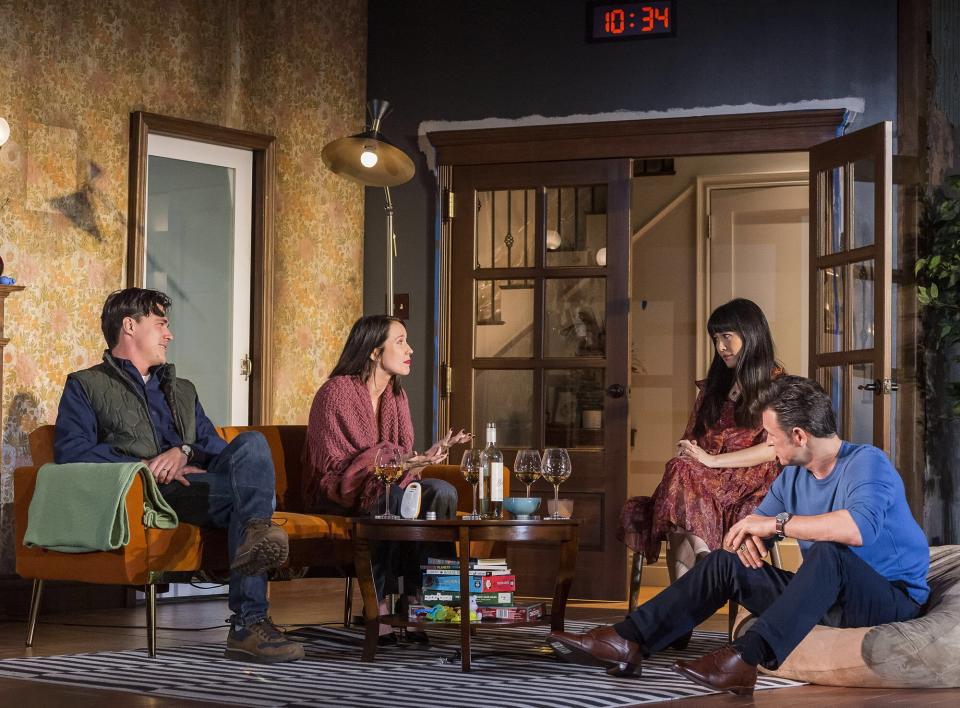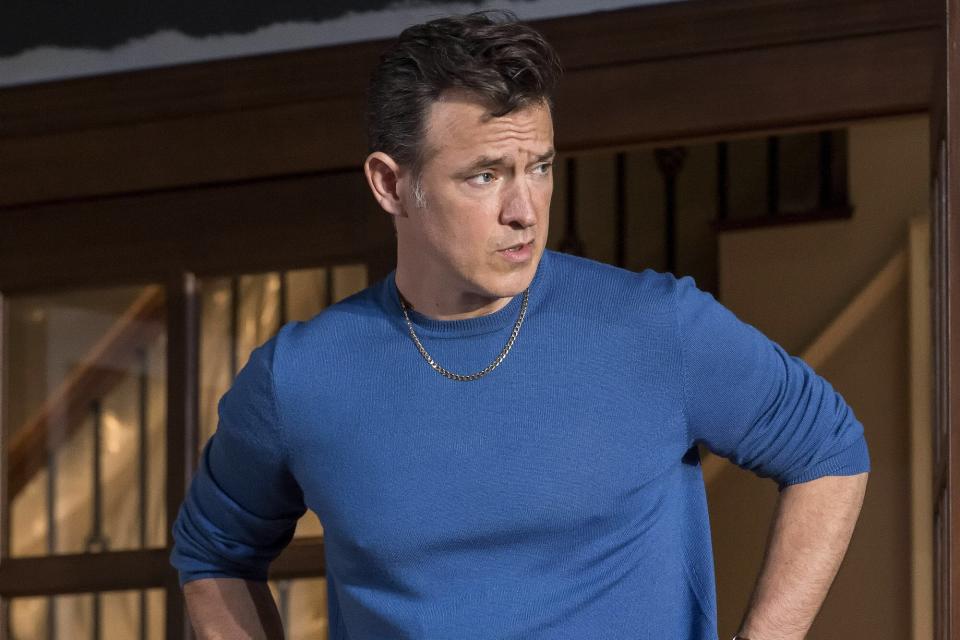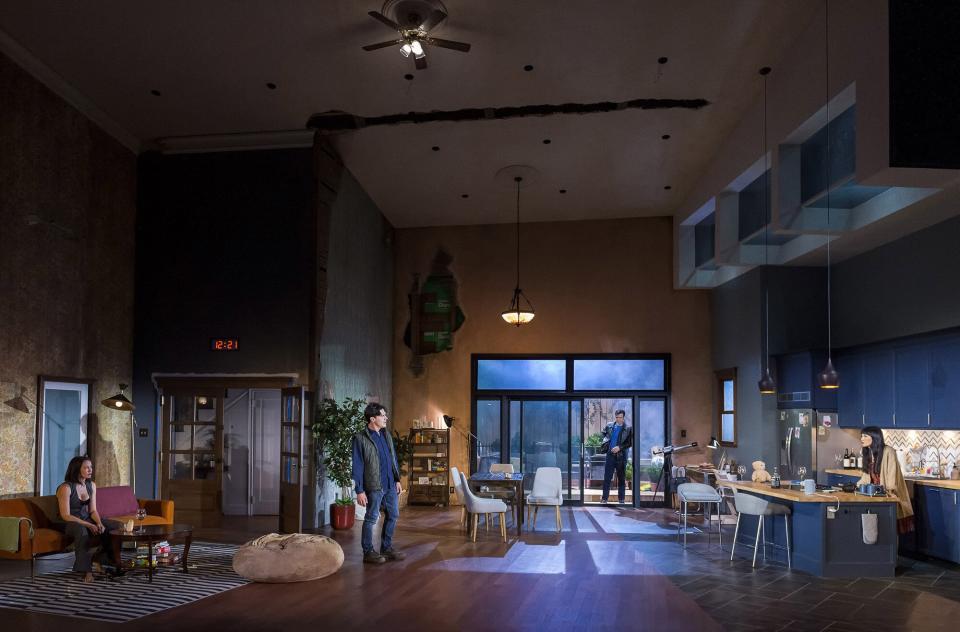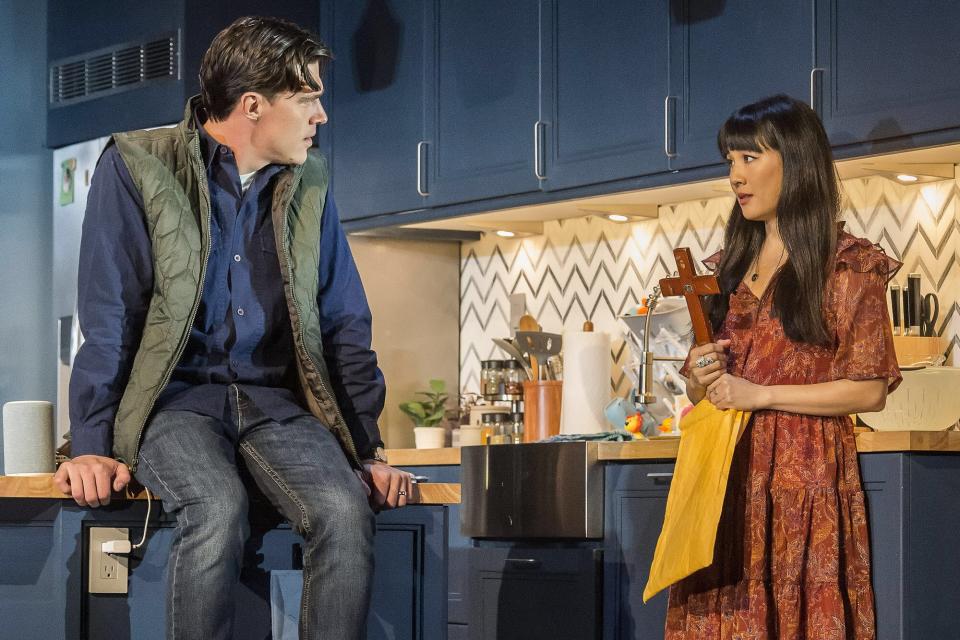2:22 A Ghost Story review: Constance Wu is haunted in eerie tale fit for a winter's night

What is a ghost really? A supernatural terror, a manifestation of our fear or our grief, something benign or far more sinister?
This is the question at the heart of 2:22 A Ghost Story, the spectral thriller now making its U.S. premiere at Center Theatre Group's Ahmanson Theater.
Jenny (Constance Wu) is being haunted — each night at 2:22 a.m., she hears what she believes is a ghost circling her baby's crib and crying. But when her husband, Sam (Finn Wittrock), returns home from a business trip and they welcome old friend Lauren (Anna Camp) and her contractor boyfriend Ben (Adam Rothenberg) for dinner, beliefs are challenged and old wounds are exposed.

Craig Schwartz
Danny Robbins' script wants to both probe the very nature of haunting, and the cultural value of ghosts, while also delivering up some genuine scares in the process. Utterly rational Sam faces off against Jenny's certainty in what she's seen, as Sam tries to draw a drunken Lauren and spiritual Ben to his side in an evening that puts all of their faith (and their relationships) to the test.
The play itself perhaps wants to have its ghostly cake and eat it too. Is it a philosophical debate or a horror story? There's no reason it can't be both. Horror has long been a genre on which we project and probe some of life's greatest questions (and societal bugaboos). But the play never does seem to find the balance between those two aims, the pat-ness of its conclusion satisfying the horror narrative while slightly invalidating the provocative questions at its center.
This may be more a fault of Matthew Dunster's direction than Robbins' writing. While Wittrock and Rothenberg are grounded and believable as Sam and Ben, the women don't fare so kindly (one has to wonder if perhaps Dunster is just more adept at directing men). Both Wu and Camp come off a bit histrionic, as if their desire to play to the rafters (an admittedly difficult task in the Ahmanson) subsumes anything else. The result is that their performances carry a strong whiff of "acting" with a capital A.

Craig Schwartz
Rothenberg — though the least recognizable name of the four as a Ozark season 4 series regular — is the show's ace in the hole. His blue-collar believer is at turns dryly funny, wearily indignant, and vociferously committed to the things he is certain are true. His expertly pitched Boston accent gives him a specificity of time and place that the other characters lack. Like near-ghosts themselves, the other three float through the action. Rothenberg is the only stolid presence here.
Wittrock does admirable, self-assured work as Sam, selling the smug non-believer act to a tee (though one does have to wonder what Jenny ever saw in him).
As the play ratchets up its terrors, Wu and Camp sink into their roles more decisively. If the first act notably feels like they're reciting a script, the second act gives them something to sink their teeth into. They both arrive at cataclysmic climaxes, and they carry those moments with a sense of shock and awe.

Craig Schwartz
The show's design is deceptively effective, the cavernous set design of Anna Fleischle giving the characters a disturbingly cold and empty space in which to traffic. The design itself feels otherworldly, its gaping chasm between kitchen and living room unsettlingly off, but in a way that creeps into the audience's consciousness.
Above it all hovers a menacing red digital clock that counts down to the titular 2:22 with a perpetual dread. It's a brilliant hook, a blinking, ever-present reminder of the moment the characters and the audience are both waiting for with bated breath. It's never clear if the characters themselves can see the clock, making it an even more chilling presence, ticking away to a moment of truth.
So much of what makes an effective scare is dependent on sound — what we hear, what we don't, pregnant pauses, and things that go bump in the night. Ian Dickinson's sound design for Autograph is the stuff of true nightmares, a searing shriek that rends the proceedings, serving as a scene transition that makes audiences jump in their seats every damn time. The show's coyote howls are more cartoonish than hair-raising, but the nuanced use of diegetic sound helps sell the wide range of effects, from domestic to eerie, that dot the action.

Craig Schwartz
2:22 A Ghost Story posits one explanation for hauntings — that of an experience akin to a Facebook memory, a reminder of an existence, a past that burns brighter in one's consciousness for the brief moment it is presented to you. It's a lovely notion, one far friendlier than the malicious intentions of a poltergeist.
But ultimately, 2:22 is less about what and why someone believes (there's a potent undercurrent here of gaslighting and the trenchant difficulties women face getting men to believe them) than it sets out to be. It's genuinely scary, a haunting piece of art in the literal sense. But the script is rife with plot holes and some persnickety pacing challenges (it'd probably be more effective as a 100 minute rollercoaster with no intermission). Its ending, while shocking and terrifying in equal measure, eliminates the purpose of much of its most intriguing philosophizing.
At its outset, the play is a frightening theatrical experience, but one that is also invested in metaphysical questions of belief and our need to project our fears, our loss, our loves, and our frustrations onto a spectral presence. But it ultimately pivots away from these larger questions of why we believe in ghosts and whether we should to satisfy a hunger for a conclusive explanation. It fails to recognize that the most haunting thing of all are life's questions for which there are no easy answers. B
Related content:

